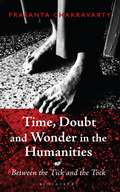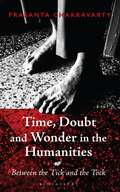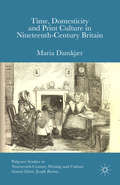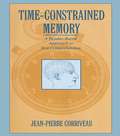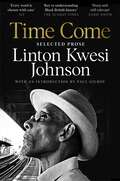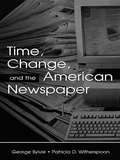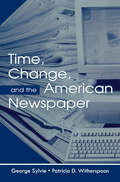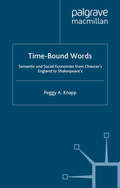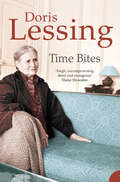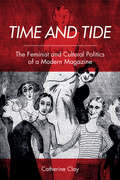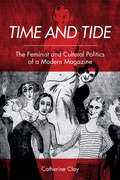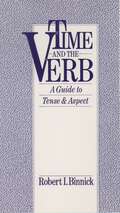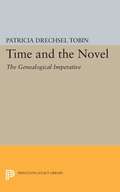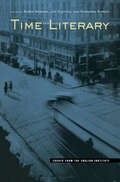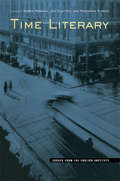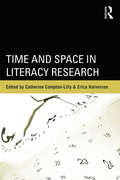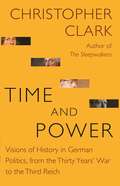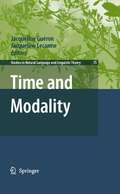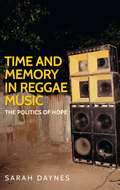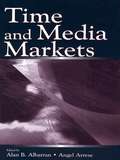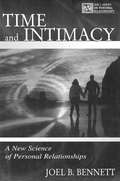- Table View
- List View
Time, Doubt and Wonder in the Humanities: Between the Tick and the Tock
by Prasanta ChakravartyTime, Doubt and Wonder in the Humanities addresses a serious lacuna in humanities studies. It affirms our commitment to wonder and adventure in living by confronting the subtext that lies within the manifold worldly, social and political vicissitudes and tribulations. The essays in this volume speak to our times and make sense of the idea of temporality in general by using wonder as an inclusive metaphor, which engulfs fortitude, anguish, joy, providence, submission, precariousness and revulsion. Wonder could lead to curiosity to inspiration to doubt to questioning to indignation to seeking of justice. The book offers a benchmark in thinking about why we must take literature and art seriously in times of great political turmoil. It affirms that the shape and contour of literary studies shall depend on how the coming generation maintains a delicate balance among inspiration, doubt and faith.
Time, Doubt and Wonder in the Humanities: Between the Tick and the Tock
by Prasanta ChakravartyTime, Doubt and Wonder in the Humanities addresses a serious lacuna in humanities studies. It affirms our commitment to wonder and adventure in living by confronting the subtext that lies within the manifold worldly, social and political vicissitudes and tribulations. The essays in this volume speak to our times and make sense of the idea of temporality in general by using wonder as an inclusive metaphor, which engulfs fortitude, anguish, joy, providence, submission, precariousness and revulsion. Wonder could lead to curiosity to inspiration to doubt to questioning to indignation to seeking of justice. The book offers a benchmark in thinking about why we must take literature and art seriously in times of great political turmoil. It affirms that the shape and contour of literary studies shall depend on how the coming generation maintains a delicate balance among inspiration, doubt and faith.
Time, Domesticity and Print Culture in Nineteenth-Century Britain (Palgrave Studies in Nineteenth-Century Writing and Culture)
by M. DamkjærThis innovative study shows that nineteenth-century texts gave domesticity not just a spatial but also a temporal dimension. Novels by Dickens and Gaskell, as well as periodicals, cookery books and albums, all showed domesticity as a process. Damkjær argues that texts' material form had a profound influence on their representation of domestic time.
Time-constrained Memory: A Reader-based Approach To Text Comprehension
by Jean-Pierre CorriveauThis book tries to answer the question posed by Minsky at the beginning of The Society of Mind: "to explain the mind, we have to show how minds are built from mindless stuff, from parts that are much smaller and simpler than anything we'd considered smart." The author believes that cognition should not be rooted in innate rules and primitives, but rather grounded in human memory. More specifically, he suggests viewing linguistic comprehension as a time-constrained process -- a race for building an interpretation in short term memory. After reviewing existing psychological and computational approaches to text understanding and concluding that they generally rely on self-validating primitives, the author abandons this objectivist and normative approach to meaning and develops a set of requirements for a grounded cognitive architecture. He then goes on to explain how this architecture must avoid all epistemological commitments, be tractable both with respect to space and time, and, most importantly, account for the diachronic and non-deterministic nature of comprehension. In other words, a text may or may not lead to an interpretation for a specific reader, and may be associated with several interpretations over time by one reader. Throughout the remainder of the book, the author demonstrates that rules for all major facets of comprehension -- syntax, reference resolution, quantification, lexical and structural disambiguation, inference and subject matter -- can be expressed in terms of the simple mechanistic computing elements of a massively parallel network modeling memory. These elements, called knowledge units, work in a limited amount of time and have the ability not only to recognize but also to build the structures that make up an interpretation. Designed as a main text for graduate courses, this volume is essential to the fields of cognitive science, artificial intelligence, memory modeling, text understanding, computational linguistics and natural language understanding. Other areas of application are schema-matching, hermeneutics, local connectionism, and text linguistics. With its extensive bibliography, the book is also valuable as supplemental reading for introductory undergraduate courses in cognitive science and computational linguistics.
Time-constrained Memory: A Reader-based Approach To Text Comprehension
by Jean-Pierre CorriveauThis book tries to answer the question posed by Minsky at the beginning of The Society of Mind: "to explain the mind, we have to show how minds are built from mindless stuff, from parts that are much smaller and simpler than anything we'd considered smart." The author believes that cognition should not be rooted in innate rules and primitives, but rather grounded in human memory. More specifically, he suggests viewing linguistic comprehension as a time-constrained process -- a race for building an interpretation in short term memory. After reviewing existing psychological and computational approaches to text understanding and concluding that they generally rely on self-validating primitives, the author abandons this objectivist and normative approach to meaning and develops a set of requirements for a grounded cognitive architecture. He then goes on to explain how this architecture must avoid all epistemological commitments, be tractable both with respect to space and time, and, most importantly, account for the diachronic and non-deterministic nature of comprehension. In other words, a text may or may not lead to an interpretation for a specific reader, and may be associated with several interpretations over time by one reader. Throughout the remainder of the book, the author demonstrates that rules for all major facets of comprehension -- syntax, reference resolution, quantification, lexical and structural disambiguation, inference and subject matter -- can be expressed in terms of the simple mechanistic computing elements of a massively parallel network modeling memory. These elements, called knowledge units, work in a limited amount of time and have the ability not only to recognize but also to build the structures that make up an interpretation. Designed as a main text for graduate courses, this volume is essential to the fields of cognitive science, artificial intelligence, memory modeling, text understanding, computational linguistics and natural language understanding. Other areas of application are schema-matching, hermeneutics, local connectionism, and text linguistics. With its extensive bibliography, the book is also valuable as supplemental reading for introductory undergraduate courses in cognitive science and computational linguistics.
Time Come: Selected Prose
by Linton Kwesi Johnson‘Key to understanding Black British history’ – The Sunday Times‘Sharp and still relevant’ – Zadie SmithOne of the great poets of modern times, and a deeply respected political and cultural activist and social critic, Linton Kwesi Johnson is also a prolific writer of non-fiction. In Time Come, he selects some of his most powerful prose – book and music reviews published in newspapers and magazines, lectures, obituaries and speeches – for the first time. Written over many decades, these works draw on Johnson’s own Jamaican roots and on Caribbean history to explore the politics of race that continue to inform the Black British experience.Ranging from reflections on the place of music in Caribbean and Black British culture as a creative, defiant response to oppression, to penetrating appraisals of novels, films, poems and plays, and including warm tributes paid to the activists and artists who inspired him to contribute to the struggle for racial equality and social justice, Time Come is a panorama of an exceptional life. Venturing into memoir, it underscores Johnson’s enduring importance in Britain’s cultural history and reminds us of his brilliant, unparalleled legacy.With an introduction by Paul Gilroy, author of There Ain’t No Black in the Union Jack.‘A mosaic of wise, urgent and moving pieces’ – Kit de Waal‘As necessary as ever’ – The Observer‘A book to be savoured and re-read’ – Derek Owusu‘An outstanding collection’ – Caryl Phillips‘A necessary book from a writer who continues to inspire’ – Yomi Sode‘Incisive, engaging, fearless’ – Gary Younge
Time, Change, and the American Newspaper (Routledge Communication Series)
by George Sylvie Patricia D. WitherspoonTime, Change, and the American Newspaper focuses on newspapers as organizations, examining the role of change in the newspaper industry and providing a model from which to view and respond to change. Authors George Sylvie and Patricia D. Witherspoon discuss environmental and organizational influences on contemporary newspapers, and they analyze newspapers within the larger context of all organizations. This more general perspective provides insights into the nature of change, the change process, the rationale for organizational changes, resistance to such changes, and initiation and implementation strategies. In its examination of change, this volume explores the causes of newspaper change, how newspaper change takes shape, and when change does not work. This consideration sets the stage for detailed case studies examining the roles of new technology, product, and people as change agents in newspapers. The discussion concludes with the impact of change--or lack of it--on the contemporary newspaper industry and the subsequent impact of newspaper change on society. Sylvie and Witherspoon propose future directions of change and of newspaper decision-making processes pertaining to change, and they offer suggestions for changes in newspaper structures and thought processes. Providing a sound, theoretically-based approach to the topic of change and American newspapers, this volume is essential reading for educators and students in journalism, media/newsroom management, media economics, organizational behavior/communication, and related areas. It also provides a wealth of insights and practical knowledge for newspaper publishers, editors, and practicing journalists.
Time, Change, and the American Newspaper (Routledge Communication Series)
by George Sylvie Patricia D. WitherspoonTime, Change, and the American Newspaper focuses on newspapers as organizations, examining the role of change in the newspaper industry and providing a model from which to view and respond to change. Authors George Sylvie and Patricia D. Witherspoon discuss environmental and organizational influences on contemporary newspapers, and they analyze newspapers within the larger context of all organizations. This more general perspective provides insights into the nature of change, the change process, the rationale for organizational changes, resistance to such changes, and initiation and implementation strategies. In its examination of change, this volume explores the causes of newspaper change, how newspaper change takes shape, and when change does not work. This consideration sets the stage for detailed case studies examining the roles of new technology, product, and people as change agents in newspapers. The discussion concludes with the impact of change--or lack of it--on the contemporary newspaper industry and the subsequent impact of newspaper change on society. Sylvie and Witherspoon propose future directions of change and of newspaper decision-making processes pertaining to change, and they offer suggestions for changes in newspaper structures and thought processes. Providing a sound, theoretically-based approach to the topic of change and American newspapers, this volume is essential reading for educators and students in journalism, media/newsroom management, media economics, organizational behavior/communication, and related areas. It also provides a wealth of insights and practical knowledge for newspaper publishers, editors, and practicing journalists.
Time-Bound Words: Semantic and Social Economies from Chaucer's England to Shakespeare's
by P. KnappTime-Bound Words argues that changes in English society and the English language are woven together, often in surprising ways, and investigates this claim by following eleven words from Chaucer's time to Shakespeare's. Middle English words like corage, estat, thrift , and virtù come to serve the logic of new social discourses by 1611. Language from Chaucer, Wyclif, More, Spenser, Shakespeare, Jonson and others is examined both as current and emerging usage, and as verbal play that accomplishes cultural work.
Time Bites: Views And Reviews
by Doris LessingAssembled here for the first time in book form are the very best occasional writings from the winner of the Nobel Prize for Literature.
Time and Tide: The Feminist and Cultural Politics of a Modern Magazine
by Catherine ClayScrutinises the political strategies and ideological evolution of Islamist actors and forces following the Arab uprisings
Time and Tide: The Feminist and Cultural Politics of a Modern Magazine
by Catherine ClayCharts the origins and development of the little magazine genre in the Victorian period
Time and the Verb: A Guide to Tense and Aspect
by Robert I. BinnickThis comprehensive examination of tense and grammatical aspect provides fascinating insight into how languages indicate distinctions of time. Providing an in-depth survey of the scholarship from the ancient Greeks through the 1980s, Time and the Verb explains and evaluates every major issue and theory, concentrating on familiar Classical and modern European languages. An invaluable reference tool as well as a major contribution to the history of linguistic sciences, this book will be the standard against which future work on tense and aspect is measured.
Time and the Novel: The Genealogical Imperative
by Patricia Drechsel TobinFormalist criticism of the modern novel has concentrated on its spatial aspects. Patricia Tobin focuses, instead, on the modern novel's temporal structure. She notes that the "genealogical imperative" that dominated the nineteenth-century novel, in which one event gave birth to another, has broken down in the twentieth-century novels she studies. Further, she draws parallels between this collapse of linear narrative and the current challenge to linearity from many other areas of modern thought. Beginning with Mann's Buddenbrooks as a family chronicle novel that fully embodies the classical genealogical structure, the author extends her analysis to include distortions of the linear perspective in Lawrence's The Rainbow, Faulkner's Absalom, Absalom!, Nabokov's Ada, or Ardor, and Márquez's One Hundred Years of Solitude. She finds that in these novels about family relationships, the continuity of time, family, and story has dissolved so that past, present, and future have lost their distinctions; sins against the dynastic family are not only recognized but celebrated; and literary and existential meanings are suspended in unlikely juxtapositions, irrational metamorphoses, and proliferating possibilities. Professor Tobin suggests that the disappearance of the genealogical imperative in the contemporary world's sense of reality may account for much of what appears to be anonymous, peripheral, and excessive in post-modern fiction.Originally published in 1979.The Princeton Legacy Library uses the latest print-on-demand technology to again make available previously out-of-print books from the distinguished backlist of Princeton University Press. These editions preserve the original texts of these important books while presenting them in durable paperback and hardcover editions. The goal of the Princeton Legacy Library is to vastly increase access to the rich scholarly heritage found in the thousands of books published by Princeton University Press since its founding in 1905.
Time and the Literary (Essays from the English Institute)
by Karen Newman Jay Clayton Marianne HirschTime and the literary: the immediacy of information technology has supposedly annihilated both. Email, cell phones, satellite broadcasting seem to have ended the long-standing tradition of encoding our experience of time through writing. Paul de Man's seminal essay "Literary History and Literary Modernity" and newly commissioned essays on everything from the human genome to grammatical tenses argue, however that the literary constantly reconstructs our understanding of time. From eleventh-century France or a science-fiction future, Time and the Literary shows how these two concepts have been and will continue to influence each other.
Time and the Literary (Essays from the English Institute)
by Karen Newman Jay Clayton Marianne HirschTime and the literary: the immediacy of information technology has supposedly annihilated both. Email, cell phones, satellite broadcasting seem to have ended the long-standing tradition of encoding our experience of time through writing. Paul de Man's seminal essay "Literary History and Literary Modernity" and newly commissioned essays on everything from the human genome to grammatical tenses argue, however that the literary constantly reconstructs our understanding of time. From eleventh-century France or a science-fiction future, Time and the Literary shows how these two concepts have been and will continue to influence each other.
Time and Space in Literacy Research
by Catherine Compton-Lilly Erica HalversonLiteracy researchers interested in how specific sites of learning situate students and the ways they make sense of their worlds are asking new questions and thinking in new ways about how time and space operate as contextual dimensions in the learning lives of students, teachers, and families. These investigations inform questions related to history, identity, methodology, in-school and out-of school spaces, and local/global literacies. An engaging blend of methodological, theoretical, and empirical work featuring well-known researchers on the topic, this book provides a conceptual framework for extending existing conceptions of context and provides unique and ground-breaking examples of empirical research.
Time and Space in Literacy Research
by Catherine Compton-Lilly Erica HalversonLiteracy researchers interested in how specific sites of learning situate students and the ways they make sense of their worlds are asking new questions and thinking in new ways about how time and space operate as contextual dimensions in the learning lives of students, teachers, and families. These investigations inform questions related to history, identity, methodology, in-school and out-of school spaces, and local/global literacies. An engaging blend of methodological, theoretical, and empirical work featuring well-known researchers on the topic, this book provides a conceptual framework for extending existing conceptions of context and provides unique and ground-breaking examples of empirical research.
Time and Power: Visions of History in German Politics, from the Thirty Years' War to the Third Reich (The\lawrence Stone Lectures #11)
by Christopher ClarkFrom the author of the national bestseller The Sleepwalkers, a book about how the exercise of power is shaped by different concepts of timeThis groundbreaking book presents new perspectives on how the exercise of power is shaped by different notions of time. Acclaimed historian Christopher Clark draws on four key figures from German history—Friedrich Wilhelm of Brandenburg-Prussia, Frederick the Great, Otto von Bismarck, and Adolf Hitler—to look at history through a temporal lens and ask how historical actors and their regimes embody unique conceptions of time.Inspired by the insights of Reinhart Koselleck and François Hartog, two pioneers of the “temporal turn” in historiography, Clark shows how Friedrich Wilhelm rejected the notion of continuity with the past, believing instead that a sovereign must liberate the state from the entanglements of tradition to choose freely among different possible futures. He demonstrates how Frederick the Great abandoned this paradigm for a neoclassical vision of history in which sovereign and state transcend time altogether, and how Bismarck believed that the statesman’s duty was to preserve the timeless permanence of the state amid the torrent of historical change. Clark describes how Hitler did not seek to revolutionize history like Stalin and Mussolini, but instead sought to evade history altogether, emphasizing timeless racial archetypes and a prophetically foretold future.Elegantly written and boldly innovative, Time and Power takes readers from the Thirty Years’ War to the fall of the Third Reich, revealing the connection between political power and the distinct temporalities of the leaders who wield it.
Time and Modality (Studies in Natural Language and Linguistic Theory #75)
by Jacqueline Guéron Jacqueline LecarmeTime and memory in reggae music: The politics of hope (PDF) (Music and Society)
by Sarah DaynesOn the basis of a body of reggae songs from the 1970s and late 1990s, this book offers a sociological analysis of memory, hope and redemption in reggae music. From Dennis Brown to Sizzla, the way in which reggae music constructs a musical, religious and socio-political memory in rupture with dominant models is vividly illustrated by the lyrics themselves. How is the past remembered in the present? How does remembering the past allow for imagining the future? How does collective memory participate in the historical grounding of collective identity? What is the relationship between tradition and revolution, between the recollection of the past and the imagination of the future, between passivity and action? Ultimately, this case study of ‘memory at work’ opens up a theoretical problem: the conceptualization of time and its relationship with memory.
Time and memory in reggae music: The politics of hope (Music and Society)
by Sarah DaynesOn the basis of a body of reggae songs from the 1970s and late 1990s, this book offers a sociological analysis of memory, hope and redemption in reggae music. From Dennis Brown to Sizzla, the way in which reggae music constructs a musical, religious and socio-political memory in rupture with dominant models is vividly illustrated by the lyrics themselves. How is the past remembered in the present? How does remembering the past allow for imagining the future? How does collective memory participate in the historical grounding of collective identity? What is the relationship between tradition and revolution, between the recollection of the past and the imagination of the future, between passivity and action? Ultimately, this case study of ‘memory at work’ opens up a theoretical problem: the conceptualization of time and its relationship with memory.
Time and Media Markets (Routledge Communication Series)
by Alan B. Albarran Angel Arrese RecaThis edited collection examines time and its relationship to and impact upon media industries, studying how the media industry views time and makes business and economic decisions based on considerations of time. Contributions from an international set of authors analyze time constraints and competition between different media; the quantity and quality of time spent in media consumption, audience and readership time valuation/costing/pricing; and the emergence of new media businesses around individual time management. Specific topics examined in the volume include: * a philosophical look at the concept of time and its application to media markets; * temporal aspects of media distribution for the media industries, and how time affects their activities; * the impact of increasing media industry consolidation and convergence on managerial effectiveness; * approaches to time by CNN and its various cache of news channels, in a managerial context; * the application of niche theory as a framework to examine competition between the Internet and television; * Internet access in the United Kingdom and Europe, examining the cost of time for online access; * the exchange of time and money in the television market for advertising; and * a summary of research and an agenda for future research on the topic of time's role in the media industry and markets. With its origins in the third World Media Economics conference, held in 2000, Time and Media Markets is a distinctive and important collection appropriate for scholars and advanced students in media management and economics.
Time and Media Markets (Routledge Communication Series)
by Alan B. Albarran Angel Arrese RecaThis edited collection examines time and its relationship to and impact upon media industries, studying how the media industry views time and makes business and economic decisions based on considerations of time. Contributions from an international set of authors analyze time constraints and competition between different media; the quantity and quality of time spent in media consumption, audience and readership time valuation/costing/pricing; and the emergence of new media businesses around individual time management. Specific topics examined in the volume include: * a philosophical look at the concept of time and its application to media markets; * temporal aspects of media distribution for the media industries, and how time affects their activities; * the impact of increasing media industry consolidation and convergence on managerial effectiveness; * approaches to time by CNN and its various cache of news channels, in a managerial context; * the application of niche theory as a framework to examine competition between the Internet and television; * Internet access in the United Kingdom and Europe, examining the cost of time for online access; * the exchange of time and money in the television market for advertising; and * a summary of research and an agenda for future research on the topic of time's role in the media industry and markets. With its origins in the third World Media Economics conference, held in 2000, Time and Media Markets is a distinctive and important collection appropriate for scholars and advanced students in media management and economics.
Time and Intimacy: A New Science of Personal Relationships (LEA's Series on Personal Relationships)
by Joel B. BennettThere is a mysterious connection between our experiences of intimacy--of love, the longing to feel connected, and sexual embrace--and the human sense of time--eternity, impermanence, and rhythm. In this critical analysis of the time-intimacy equation, Bennett shows how the scientific study of personal relationships can address this mystery. As a study of transpersonal science, this book points to the possible evolution of intimacy and of our consciousness of time, and how the two evolutionary paths weave together. Dr. Bennett draws from a wide array of resources to advance and marry two compelling themes: first, the social and clinical science of personal relationships should integrate the spiritual or transpersonal dimension of intimacy, and second, science can contribute to lay understandings by describing the richly temporal aspects of relationships. In blending popular literature, transpersonal psychology, and scientific research and theory, this work also attempts to address the lack of dialogue between academics who study personal intimacy and those writers in the popular press who give advice and guidelines for building intimacy. Time and Intimacy is written for a broad audience, intended for those with a general interest in relationships, as well as for students, counselors, and psychologists. It can be used as a text in courses on personal relationships, as well as to supplement courses in humanistic psychology, transpersonal psychology, interpersonal communication, relationships, marital and family counseling, human relations, and related areas. Because it advances an interdisciplinary understanding of personal relationships, this book is certain to challenge prevailing views about the meaning of intimacy in both the academic and popular literatures.
